Search myodfw.com
Smaller than a robin, this shy skulker is difficult to see, even though it is present during the nesting season in marshes throughout the state. The Sora is mostly brown with a black face and a stout yellow bill. Its chicks are small black balls of fluff with a bit of orange feathering under their chins. In the breeding season, Soras use wet meadows, including sedge, rush, and hair grass types but also wet areas with emergent vegetation, particularly cattails and tulles. They eat invertebrates, seeds, plant leaves, and stems. Hear the call of the Sora Photo by Kathy Munsel

Western Oregon observers enjoy these large, elegant plovers almost year-round, and as a consequence they are one of the most familiar larger shorebirds. Almost all migrants and winterers visiting Oregon inhabit mudflats and open wet dirt fields. A few can be found on sand beaches and even occasionally on rocks, but the great majority are found feeding and resting on open mud. In Oregon, it is a fairly common to common transient in western interior valleys. East of the Cascades, the Black-bellied plover is an uncommon transient in the Klamath Basin and at Malheur National Wildlife Refuge. In winter it

This gull nests on offshore islands, rocky coastal cliffs, and sometimes in grass on level parts of headlands. It forages in the marine and intertidal environments. Glaucous-winged gulls eat just about any animal material they find. They take small fish, barnacles, molluscs, sea urchins, bird eggs, carrion and animal waste discarded from fishing boats. It is rare but regular along the coast and the Columbia River; local and rare in the Willamette Valley. In can be uncommon midwinter at Sauvie Island. Most Glaucous-winged gulls in Oregon nest in the mouth of the Columbia River. Hear the call of the Glaucous-winged
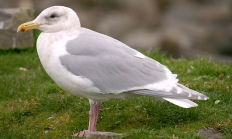
In winter plumage, the crisp black head, white neck patch, and gray back are striking, and when combined with a pale bill this species is readily distinguished from small alcids in Oregon. Wing-propelled divers, they are nonbreeding visitors to Oregon's offshore waters. They are the only seabirds whose young are reared entirely at sea. The Ancient murrelet is an uncommon to common fall migrant and winter visitant in shelf waters near shore; rare to uncommon in spring; absent to rare in summer. Hear the call of the Ancient murrelet Photo by Patty Mcgann, Flickr

The Rock pigeon is an invasive species introduced from Europe. It is found in and about human-created structures, e.g., masonry buildings, parking structures, barns, abandoned houses, bridges, water towers and freeway overpasses that posses cornices, ledges, and cave-like cavities used for nesting and shelter. Pigeons forage in city streets and parks on food refuse, public handouts, and weed seeds, and on grain spilled at shipping facilities and along transportation corridors. In agricultural areas they forage in livestock feedlots and fields. It is common to abundant statewide in cities, towns and agricultural areas. Hear the call of the Rock pigeon Photo

Almost strictly nocturnal, the Western screech-owl hunts discreetly at night and roosts during the day in dense woodlands, its perfectly streaked plumage allows it to pass as tree bark. These habits make it difficult to see, and it is more common than many are aware. It is a small owl with yellow eyes and feathered ear tufts. It exhibits geographic variation in plumage color and pattern: both gray morphs and brown morphs occur in the Pacific Northwest. Sexes are alike. The Western screech-owl is a fairly common year-round resident in lower-elevation woodlands throughout Oregon. It is usually found below 3,000
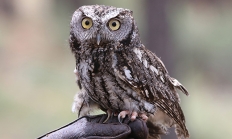
High overhead at the top of the rimrock in Oregon's desert country, the White-throated swift swoops, soars, and darts about erratically, hunting and catching insects. At great speed, it disappears into a crevice on a cliff without appearing to slow down. Its long, strong claws enable it to crawl deep inside these crevices to roosting and nesting areas, which often cannot be seen from the entrance. This bird is a locally common to abundant breeder, primarily on eastern Oregon cliffs. It is an occasional spring and sporadic fall migrant in western Oregon along the coast, in the Willamette Valley, and
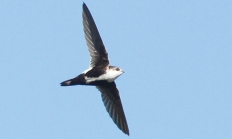
Allen's hummingbird is a common breeder in the coastal fog belt from California into southern Oregon. It is closely related to the more wide-ranging Rufous hummingbird with only subtle differences in plumage, behavior, and vocalization. This is a fairly common spring and summer resident along the southern Oregon coast as far north as Bandon. It occurs as a very rare vagrant in other parts of western Oregon. Hear the call of the Allen's hummingbird Photo by Trish Gussler, Flickr

The Pileated woodpecker was the model for the cartoon character, Woody Woodpecker. It is a large black-and-white bird with a bold red feathered crest and distinctive call. You may hear its powerful drumming before you see it. In Oregon, its habitat includes older forests in the Blue Mountains, East and West Cascades, Klamath Mountains, Willamette Valley and Coast Range ecoregions. They prefer mature forests and younger forests with large snags and logs, requiring large diameter snags for nesting and foraging. Pileated woodpeckers are an Oregon Conservation Strategy Species in the Blue Mountains ecoregion. Hear the call and the drumming of
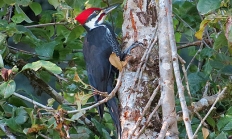
This small greenish flycatcher is easily overlooked in the moist, shady forests where it makes its summer home. It is a common to abundant breeder in forests of the Coast Range and west Cascades below about 4,000 feet and a common transient in western Oregon. The Pacific-slope flycatcher is most easily detected and identified by voice, but there is incongruence between published descriptions of vocalizations and some birds heard in the field lessens the certainty of identification to species, especially those in eastern Oregon. Hear the sounds of the Pacific-slope flycatcher Photo by Trish Gussler, Flickr
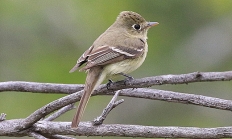
This is the larger of Oregon's two shrikes, and the more likely to be seen in winter. Most of those seen in Oregon are hatch-year birds wearing brownish plumage in the fall and graying as winter passes. Adults stand out from young of the year with more crisp gray, black, and white plumage. Shrikes inhabit open landscapes. They resemble and act like small raptors, however, they capture and kill prey with a hooked bill rather than with talons. The Northern shrike is an uncommon to locally common visitor in open habitats statewide. It is absent some years along the southern

This is one of the most audacious of Oregon's resident avifauna both in appearance and behavior. Its black coat and streaming tail dappled in blue-green iridescence contrasts starkly with its flashing white wing feathers during flight. Common and conspicuous east of the Cascades, the magpie prefers open areas stippled with dense thickets or trees. They are highly social, often gathering in large flocks. Historically despised and persecuted by hunters, farmers, and ranchers, this trickster has flourished in the tradition of the coyote. Hear the call of the Black-billed magpie Photo by Kathy Munsel, ODFW

Dashing and darting about, flashing its bright white underparts, the Violet-green Swallow is one of the characteristic birds of summer. Unlike the Tree Swallow it commonly nests in niches and cavities on urban buildings and readily uses nesting boxes in residential areas. Its soft twittery call notes are a familiar pre-dawn sound as they fly about overhead. The Violet-green swallow is a very early spring migrant concentrating about streams and wetlands where emerging insects can be found until warmer weather allows them to move into more upland areas. It is a common to abundant summer resident and breeding species throughout

Among the largest of the world's nuthatches, White-breasted nuthatches also are noteworthy for an extensive repertoire of unusual behaviors and habits. Unlike most other North American passerines, White-breasted nuthatches maintain close pair bonds over most of the year. In spring, they cement their pair bond by exhibiting a variety of courtship displays. Elaborate display rituals also are used in antagonistic territorial interactions, and distraction displays are used to deter predators. The White-breasted nuthatch is common in western Oregon lowlands. It is most abundant in southwestern interior valleys, with specimens from Salem to Jackson County. It occurs in oak and mixed

This eloquent wren is admired for its sweet, descending, liquid notes that echo off canyon walls. It is distinguished from other wrens by its gleaming white throat set off by gray head, rusty brown underparts and back, and bright rufous tail. Appreciated as it is, this is one of our least studied birds in part due to its frequently inaccessible habitat: cliffs, rimrock and deep canyon walls. It is a fairly common but local breeder in Oregon east of the Cascade summit; restricted to rocky cliffs or outcrops. It is more dispersed after breeding season west of known breeding range

The bold eye-ring, white outer rectrices, and intricate buff wing pattern distinguish this elegant gray thrush at close range. The scaly patterned brown juveniles are quite unique in appearance. The complex song is varied, soft and flute-like at times, strong and powerful at others. The call carries well, and is a characteristic sound of the winter bird community in juniper woodlands east of the Cascades. It is a summer resident in the Coast Range. It breeds in and near open coniferous forest stands, natural forest openings, burned areas, shelterwood cuts and clearcuts to the timberline. Hear the song of the

More often heard than seen, this eloquent singer is the quintessence of the sage-dominated Great Basin. Its pale eye, short bill, brownish-gray back, boldly streaked breast, and long, white-cornered tail distinguish this towhee-sized thrasher. It is often glimpsed darting or running low across the road, tail corners flashing, then disappearing abruptly into the brush. Its aerobatic display flight and tireless vocalizations are its most outstanding features. Hear the song of the Sage thrasher Photo by Tom Benson, Flickr

One of the most numerous breeding birds in Douglas-fir and true fir forests of western Oregon is the Hermit warbler, yet it is often overlooked. This may be surprising, given the male's bold colors; however, it seldom descends from the higher reaches of the forest canopy. If you are familiar with its song, you can often hear three to five males singing on a spring morning from many places in appropriate habitat. The male Hermit warbler has a bright yellow head, set off by a black throat and nape. The gray back is marked with black stripes that vary in

The bright yellow, red, and black plumage of the male Western Tanager, so conspicuous in open situations is very obscure in forested areas where it tends to blend into the shaded foliage. The species perhaps is best known in migration when it visits city parks, orchards, and other open urban and suburban areas. It is attracted to birdbaths but seldom to bird feeders. It breeds in open coniferous forests and mixed coniferous and deciduous woodlands, primarily in mountains. They usually nest in conifers - rarely deciduous trees - at varying heights, usually well out on a branch, often at the

Towhees, sparrows, grosbeaks and buntings are ground-dwelling birds that are typically drab looking. They feed on insects in summer and seeds in winter.

